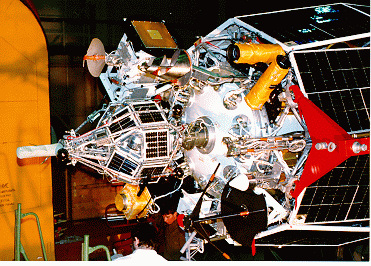December
| Detail of very low frequency electromagnetic plasma wave measurement board with electronic components encapsulated in anti-vibration material. |  |
| Detail of very low frequency electromagnetic plasma wave measurement board for the MAGION satellite with electronic components encapsulated in anti-vibration material to prevent damage during the launch due to the vibrations. All MAGION satellites studied the Earth's MAGnetosphere and IONosphere and received tele-commands from the control and receiving station Panská Ves. | |

Seal of the Society with the Latin name Societas Scientiarum Bohemica Praga and the year MDCCLXXXIV
Royal Bohemian Society of Sciences (Latin: Regia Societas Scientiarum Bohemica; German: Königliche böhmische Gesellschaft der Wissenschaften; Czech: Královská česká společnost nauk) was established in 1784 – originally without the adjective "royal" – which was granted as late as in 1790 by King and Emperor Leopold II – to be the scientific center for Lands of the Bohemian Crown. It was succeeded by the Czechoslovak Academy of Sciences in 1952, and finally became what is known today as the Czech Academy of Sciences in 1992.
Source: Wikipedia contributors, "Royal Bohemian Society of Sciences," Wikipedia, The Free Encyclopedia
The Intergovernmental Panel on Climate Change (IPCC) is an intergovernmental body of the United Nations established by the World Meteorological Organization (WMO) and the United Nations Environment Programme (UNEP). IPCC provides regular assessments of the scientific basis of climate change, its impacts and future risks, and options for adaptation and mitigation. The objective of the IPCC is to provide governments with scientific information that they can use to develop climate policies.
The Paris Agreement is an international treaty on climate change. Adopted in 2015, the agreement covers climate change mitigation, adaptation, and finance. The Paris Agreement was negotiated by 196 parties at the 2015 United Nations Climate Change Conference near Paris, France.
The Paris Agreement's long-term goal is to keep the rise in mean global temperature to well below 2 °C above pre-industrial levels, and preferably limit the increase to 1.5 °C, recognizing that this would substantially reduce the negative effects of climate change. To meet these goals, greenhouse gas emissions should be reduced as soon as possible and reach net zero by the middle of the 21st century. To stay below 1.5 °C of global warming, emissions need to be cut by roughly 50% by 2030.
 The Czechoslovak Meteorological Society (ČSMS) was a scientific society at the Czechoslovak Academy of Sciences bringing together those interested in meteorology in the former Czechoslovakia, or honorary members from abroad. The CSMS was founded in 1958 and its first chairman was Prof. RNDr. Mikuláš Konček, DrSc.
The Czechoslovak Meteorological Society (ČSMS) was a scientific society at the Czechoslovak Academy of Sciences bringing together those interested in meteorology in the former Czechoslovakia, or honorary members from abroad. The CSMS was founded in 1958 and its first chairman was Prof. RNDr. Mikuláš Konček, DrSc.
The Czech Meteorological Society was founded as a successor organization in 1993. Its activities include scientific activities, exchange of information between workers from different departments and popularization of meteorology. In its activities it uses various forms of lecture activities, such as seminars, conferences and events with international participation. The Society is governed by a Main Committee headed by a President and is a member of the Council of Scientific Societies of the Academy of Sciences of the Czech Republic and a member of the European Meteorological Society.

Magion 3
MAGION 3 was launched on 18.12.1991 to an orbit with a perigee of about 440 km and an apogee of 3070 km. The satellite's attitude was stabilized by spin and magnetic field. It measured plasma waves, ionospheric plasma parameters and the Earth's magnetic field.
 Carl-Gustaf Arvid Rossby (28 December 1898 – 19 August 1957) was a Swedish-born American meteorologist who first explained the large-scale motions of the atmosphere in terms of fluid mechanics. He identified and characterized both the jet stream and the long waves in the westerlies that were later named Rossby waves.
Carl-Gustaf Arvid Rossby (28 December 1898 – 19 August 1957) was a Swedish-born American meteorologist who first explained the large-scale motions of the atmosphere in terms of fluid mechanics. He identified and characterized both the jet stream and the long waves in the westerlies that were later named Rossby waves.
Rossby came into meteorology and oceanography while studying geophysics under Vilhelm Bjerknes at the Geophysical Institute, University of Bergen in Bergen, Norway, during 1919, where Bjerknes' group was developing the groundbreaking concepts that became known as the Bergen School of Meteorology, including theory of the polar front.
In 1925 Rossby was granted a fellowship from the Sweden-America Foundation "to study the application of the polar front theory to American weather". In the U.S. Weather Bureau in Washington, DC, he combined theoretical work on atmospheric turbulence with the establishment of the first weather service for civil aviation. In 1928 he became associate professor in the Aeronautics Department of the Massachusetts Institute of Technology (MIT). Shortly after this MIT launched the first department of meteorology in the US. In 1931 he also became a research associate at Woods Hole Oceanographic Institution. His interests during this time ranged over atmospheric thermodynamics, mixing and turbulence, and the interaction between oceans and the atmosphere.
On 9 January 1939 he became an American citizen and in that same year, assistant director of research at the U.S. Weather Bureau. His appointment as chair of the department of meteorology at the University of Chicago in 1940 began the period in which he turned his attention to large-scale atmospheric motions. He identified and characterized both the jet stream and Rossby waves in the atmosphere.
Source: "Carl-Gustaf Rossby," Wikipedia, The Free Encyclopedia.
